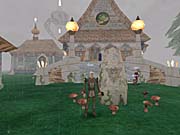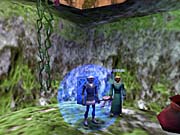Dark Age of Camelot Updated Preview
We take a look at the third realm in Mythic's upcoming massively multiplayer RPG.
If you've been following the progress of Mythic Entertainment's Dark Age of Camelot, you'll know that it's a massively multiplayer online role-playing game along the lines of EverQuest and Asheron's Call and that it's currently in closed beta testing in preparation for its release this fall. You'll also know that Dark Age of Camelot is a fantasy-themed game that draws inspiration from classical Welsh, Nordic, and British mythology. In the game, you can create characters from three different realms: Albion, which is based on ancient England; Midgard, which is based on ancient Scandinavia; and Hibernia, which is based on ancient Ireland. We've previously covered the implementation of both the kingdom of Albion and the land of Midgard. Mythic has since opened Dark Age of Camelot's third and final realm, Hibernia, to its dedicated beta testers.

Though Hibernia is the last of the three realms to be implemented, it's shaping up just as well as the other two. Unlike the more-civilized nation of Albion and the rough, inhospitable land of Midgard, Hibernia is a lush, verdant territory whose inhabitants prefer faerie tree houses and rings of toadstools to stony castles and brick huts. And unlike the people of Albion, who still owe allegiance to the throne of the late King Arthur, and the people of Midgard, who serve their Norse gods with fanatical devotion, Hibernia's residents place more importance on nature than on anything else. Some even consider it to be a deity to worship.
Though Hibernia's inhabitants would normally like nothing more than to continue their peaceful existence in the lush forests and green valleys of their homeland, the world of Dark Age of Camelot is at war. The Britons of Albion and the Norse of Midgard are each preparing experienced war parties to lay siege to their neighbors' lands. That's because after Arthur fell, each of the world's powerful relics--artifacts of great power--were separated among the three realms. The only way any of the three nations can ever hope to reunite these powerful items is to seize them forcefully from its neighbors, since each is simply too precious to relinquish. As such, swordsmen, wizards, and priests from each nation train to someday serve in a raiding party to capture an enemy relic or to defend their own nation's relics against invaders. Even Hibernia's most peaceful druids have realized that conflict between the three realms is inevitable and that unless they prepare themselves for battle, they'll be hopelessly overrun.

And so the realm's four major races have stepped forward. Players who choose to side with the nation of Hibernia will be able to create characters of the Celt, firbolg, lurikeen, and elf races. The Celt is the human race of Hibernia and is the most well rounded in terms of abilities. Firbolg are a race of huge humanoids that are said to be descended from giants, not only because of their tremendous stature, but also because of their equally tremendous strength. In contrast, the lurikeen are small, swift spirits that excel at professions that require stealth and manual dexterity. Finally, the elves are tall, thin humanoids that are the most skilled at using Hibernia's powerful arcane magics.
Of the three factions, the legions of Hibernia will be the most focused on the use of magic, in contrast to the more combat-minded Norse and the more well-rounded Britons. As with the game's other two realms, Hibernian characters will begin their lives as one of four base character classes, then will later change to a more advanced and specialized profession. But when Hibernia's base classes--the guardian, the stalker, the naturalist, and the magician--attain the fifth level of experience, they'll be able to choose from some of the most powerful magic-using classes in Dark Age of Camelot.

Like other realms, Hibernia will have two basic classes that begin their careers with magic spells; and like other spellcasting characters in other realms, they begin their lives with a set of basic spells and learn new spell sets when they change professions. Hibernia's novice spellcasters are the naturalist, Hibernia's healing priest class, and the magician, Hibernia's spellcasting wizard class. Once they've attained level 5, the naturalists of Hibernia may choose one of three advanced classes: the druid, the bard, or the warden. Of all the characters in Hibernia, druids are the most in tune with nature and are therefore equipped with the best healing and protective spells in the realm, though they lack the weapon skills of a warrior. Bards are the traveling minstrels of Hibernia, and they learn some weapon skills as well as the ability to create magical effects through song. Wardens are fighter/priest hybrids, and though naturalists learn no new sets of magic spells when they become wardens, they learn the best weapon skills of any of the other priest classes in Hibernia. Hibernian magicians may also choose from three advanced classes: the eldritch, the enchanter, and the mentalist. The Hibernian eldritch is one of the most dangerous spellcasters in the game, because the class is equipped with the powerful and ancient magic of Avalon. Enchanters are experts at changing the properties of items, monsters, and characters and may also summon magical creatures as companions. And mentalists are spellcasters with a varied arsenal of magic that includes spells that immediately damage their opponents, spells that cause damage over time, and spells that stun and confuse their enemies.

But not all Hibernians are content to focus their energies on the study of magic. The realm's other base character classes, the stealthy stalker and the weapon-wielding guardian, can choose advanced professions that'll serve as both Hibernia's reconnaissance and the front lines in the coming war. Guardians may choose to become heroes, blademasters, and champions. The Hibernian hero is the most focused melee combat class in the realm and is the most skilled at the use of arms and armor, though the class doesn't have any magic spells. Blademasters likewise have no spells but prefer to deal tremendous amounts of damage to their enemies by wielding a weapon in each hand, despite the fact that this fighting style restricts them to wearing lighter armor. Champions are the most skilled at using heavy two-handed swords and hammers and may also use a special line of combat magic--though their study of multiple disciplines makes them less skilled with weapons and armor than either the hero or blademaster. The stalker base class may opt to become either a nightshade or a ranger. The nightshade is the most adept at stealth, and though the class has not yet been implemented, it will eventually possess magic powers that'll augment its stealth abilities and make the class exceptionally well suited for scouting and ambush missions. And rangers may not be as hardy as heroes or champions, but they do possess the ability to use a weapon in each hand and are exceptionally proficient in archery.
The third and final realm of Dark Age of Camelot is shaping up extremely well, though Mythic has yet to implement some major features (including the nightshade class). The development team is focusing most of its attention toward the upcoming fourth phase of the game's beta test, which will begin in August. Beta 4 will include a huge number of new features, such as trade skills and item-crafting, which will let you fashion your own arms and armor, and Dark Age of Camelot's most intriguing feature: realm-based player-versus-player combat, in which you will actually be able to seize and defend the game's powerful relics. We'll have more coverage on Dark Age of Camelot once beta 4 is under way.
Got a news tip or want to contact us directly? Email news@gamespot.com
Join the conversation